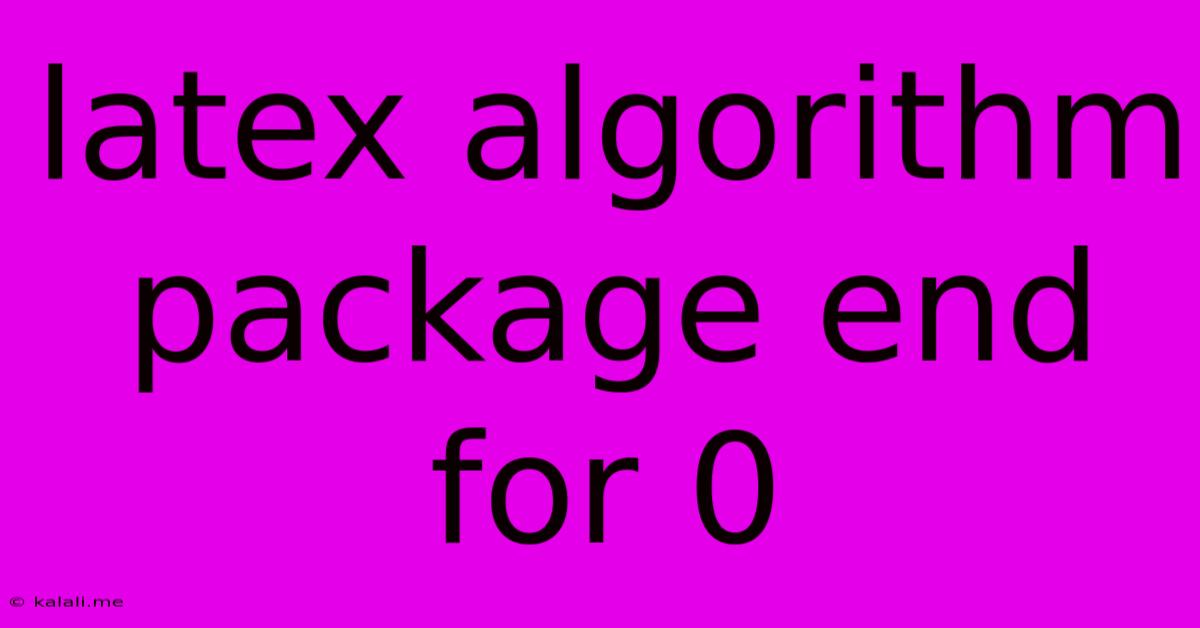Latex Algorithm Package End For 0
Kalali
May 23, 2025 · 3 min read

Table of Contents
Understanding the algorithm Package's \end{for} in LaTeX: A Comprehensive Guide
This article provides a comprehensive guide to using the \end{for} command within the algorithm package in LaTeX. We'll explore its functionality, common usage scenarios, and best practices for creating clear and well-structured algorithms. This guide is perfect for anyone wanting to improve the presentation of their algorithms in LaTeX documents, especially those involving loops and iterative processes.
The algorithm package is a popular choice for typesetting algorithms in LaTeX, offering a structured environment to enhance readability and maintain consistency. While the package provides several commands for structuring algorithms, \end{for} specifically marks the end of a for loop within the algorithm environment. It's crucial for correctly delimiting loop structures and ensuring the algorithm's visual clarity.
Basic Syntax and Usage
The \begin{for} and \end{for} commands work in tandem to define a for loop within the algorithm environment. The general syntax is:
\begin{algorithm}[H]
\caption{My Algorithm}
\begin{algorithmic}
\For{$i \gets 1$ to $n$}
% Algorithm steps within the loop
\EndFor
\end{algorithmic}
\end{algorithm}
Here:
\begin{algorithm}[H]: This initiates the algorithm environment. The[H]placement specifier forces the algorithm to appear exactly where it's placed in the code. Other options are available for more flexible placement.\caption{My Algorithm}: This provides a caption for your algorithm.\begin{algorithmic}: This begins the algorithmic pseudocode environment.\For{$i \gets 1$ to $n$}: This starts theforloop, initializing the counterifrom 1 ton. You can adjust the initialization and termination conditions as needed.% Algorithm steps within the loop: This represents the code or steps executed within each iteration of the loop.\EndFor: This marks the end of theforloop.\end{algorithmic}: This concludes the algorithmic pseudocode environment.\end{algorithm}: This closes the algorithm environment.
Advanced Usage and Best Practices
While the basic syntax is straightforward, effectively using \end{for} requires understanding several nuances:
-
Nested Loops: You can nest
forloops within each other. Ensure that each\begin{for}has a corresponding\EndFor. Proper nesting is vital for preventing compilation errors and ensuring the algorithm's logical flow is correctly represented. -
Conditional Statements: Combine
forloops with\If,\ElseIf, and\Elsestatements to create more complex algorithms with conditional logic within the loop iterations. -
Clear Indentation: Maintain consistent indentation within your
forloop to improve readability. This visually separates the loop's body from the surrounding code, making it easier to understand the algorithm's structure. -
Descriptive Variable Names: Use meaningful variable names to clarify the purpose of counters and variables in your loops. This enhances the algorithm's understandability, especially for readers unfamiliar with your specific implementation.
-
Comments: Add comments to explain complex steps or logic within your
forloops. This is crucial for maintaining clarity and ensuring that others can easily understand your algorithm.
Example with Nested Loops and Conditional Statements
\begin{algorithm}[H]
\caption{Example Algorithm with Nested Loops}
\begin{algorithmic}
\For{$i \gets 1$ to $n$}
\For{$j \gets 1$ to $m$}
\If{$i > j$}
\State $x \gets x + 1$
\Else
\State $y \gets y + 1$
\EndIf
\EndFor
\EndFor
\end{algorithmic}
\end{algorithm}
This example demonstrates a nested for loop with conditional statements, showcasing the capabilities of the algorithm package.
By following these guidelines and understanding the proper usage of \end{for}, you can effectively create well-structured and easily understandable algorithms in your LaTeX documents, significantly improving their overall quality and readability. Remember that clear and concise algorithms are not only easier to understand but also contribute to the overall professionalism and impact of your work.
Latest Posts
Latest Posts
-
How Many Cups Is 1 Pound Of Cheese
Jul 12, 2025
-
30 X 30 Is How Many Square Feet
Jul 12, 2025
-
How Much Does A Half Oz Weigh
Jul 12, 2025
-
Calories In An Omelette With 3 Eggs
Jul 12, 2025
-
How Do You Say Great Grandmother In Spanish
Jul 12, 2025
Related Post
Thank you for visiting our website which covers about Latex Algorithm Package End For 0 . We hope the information provided has been useful to you. Feel free to contact us if you have any questions or need further assistance. See you next time and don't miss to bookmark.